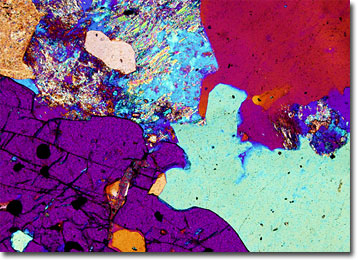Polarized Light Microscopy Digital Image Gallery
Sillimanite Garnet Gneiss
Gneiss is a type of coarse-grained rock that exhibits distinct banding, which is generally formed via regional metamorphism. Despite its foliated structure, however, unlike schists, gneiss does not exhibit perfect cleavage.

Sillimanite is an aluminum silicate that usually occurs in rocks that are rich in clay and have undergone regional metamorphism at high temperatures, such as gneisses. The mineral varies in color, but often appears glassy white, green, or brown. There also exists, however, a light blue form of sillimanite that can be found in Sri Lanka, which is sometimes utilized as a gemstone. Typically long and slender in shape, crystals of sillimanite frequently occur in fibrous masses, but are generally too brittle to be considered asbestos. Many minerals are associated with sillimanite, including quartz, biotite, feldspars, and garnets.
Garnet is a generic name for a group of silicate minerals that exhibit isomorphic crystals. Though frequently utilized in abrasives, garnets are generally most well known as gemstones. The minerals occur in a wide array of colors that ranges from white, pink, and yellow to brown, burgundy, and red. Moreover, most types of garnet typically occur as well-developed crystals, making them well suited for cutting, though others may be commonly found in granular masses. Similar to sillimanite, garnets tend to be relatively brittle and do not tend to cleave along crystalline planes.
